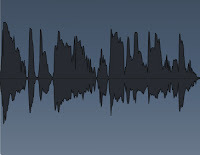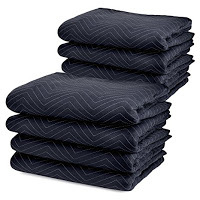Get a Room!
 This week, we begin a series of posts from narrator and Falcon Sound Company audio engineer, John Solo with some technical aspects of setting up a home studio. So, if you've been dreaming of recording your own projects in the privacy of your own home for fun and or profit, you're in luck.
This week, we begin a series of posts from narrator and Falcon Sound Company audio engineer, John Solo with some technical aspects of setting up a home studio. So, if you've been dreaming of recording your own projects in the privacy of your own home for fun and or profit, you're in luck. Ok, I get it. And I think you get it. I have a cool job (sticks his chest out and struts). I’m an audiobook narrator. In fact, short of being an astronaut or the lead singer in a long-haired rock and roll band, I can’t think of anything else I’d rather do (sometimes it sucks being a bald dude that’s not fond of flying…). So it makes sense that the response I get most frequently after someone learns what I do for a living is, “How do I get into that?!?”. This response is almost always followed up by, “My husband/wife/mother/father/boss/friend always tells me I have a voice for radio!”. Not really what I do, but ok, I get it that there are some similarities between what I do and your favorite on-air personality. There are far more similarities between a lead singer and an audiobook narrator, but they never seem to mention that one… Stupid hair.
Ok, I get it. And I think you get it. I have a cool job (sticks his chest out and struts). I’m an audiobook narrator. In fact, short of being an astronaut or the lead singer in a long-haired rock and roll band, I can’t think of anything else I’d rather do (sometimes it sucks being a bald dude that’s not fond of flying…). So it makes sense that the response I get most frequently after someone learns what I do for a living is, “How do I get into that?!?”. This response is almost always followed up by, “My husband/wife/mother/father/boss/friend always tells me I have a voice for radio!”. Not really what I do, but ok, I get it that there are some similarities between what I do and your favorite on-air personality. There are far more similarities between a lead singer and an audiobook narrator, but they never seem to mention that one… Stupid hair.It’s not as easy as it looks, but considering no one ever sees me… What the hell. Today I am going to start talking about how to setup a home studio designed specifically for voice over recording.
I need to start with a disclaimer: I am not, and will likely never be, an expert. I do not claim that anything I say is correct. In fact, I am fully aware that I am a bumbling idiot that has to mess everything up at least 3 times (sometimes many, many more.. sigh) before I blindly stumble on a solution that works. I am simply writing down what I have done and what I have learned from it. It’s free advice, people, and it’s worth
what you paid for it. :)
To record an audiobook professionally, on your own, you are required to wear 4 hats: Actor, Producer, Editor and Engineer. But, before you even get to all of that you need a studio.
To record a clean enough sound to produce an audiobook is challenging in a home environment. You have to take a few things into consideration: Room noise (external and internal noise), microphone and cabling, preamp, audio interface, and computer. Those are not laid out in any level of importance.
Today I’m going to talk about THE ROOM. Buh buh buh bummmm… There are 2 things that will mess up a voice over recording (other than the actor, bad material, and meteors): external noise (cars passing outside, dogs barking, roommate watching TV, furnace kicking on, computer fan noise) and internal noise (your mouse clicking, stomach rumbling, heavy breathing, the sound of your voice bouncing off of reflective surfaces and being recorded by your microphone, etc).
External noise is hard/expensive to fix. The only thing that stops it (especially low frequencies like car rumbles or the furnace) is mass. Mass as in concrete walls, sand, the ground, etc... There really isn't a cheap way to do it, and trust me, we tried. Our final solution was to build a cinder block room, fill the walls with sand, frame a room inside that room, double insulate it with Rockwool, and pray. We invested close to $5000.00 between material and labor, spent several months puttering around and then a concentrated 80 hour week to finish it (that was our own labor right there!), and finally it was almost isolated... almost.
Do you need to spend that kind of money and time to get a good recording? No. But it also greatly depends on your situation and your environment. Do you live in a secluded forest a few miles from civilization or do you live in the heart of a city? Those environments have a drastically different level of interfering noise. Do you intend to record 1 project a month, or 10? Less work means less time in the booth, so you can be a bit more selective about your chosen time of day for recording.
For us, we live in an area that has a lot of loud traffic; motorcycles, dump trucks, those annoying little tiny Hondas that the kids take the mufflers off of so that they sound louder… We are also fortunate enough to have a lot of work, so much so that only tracking in the late evening after those external sounds have died down isn’t an option. We needed to be able to track all day, and sometimes all night.
The best beginners' budget solution to stop outside noises is to find the quietest, most secluded space in your available area. Closets normally work really well for this, because not only do they have an extra wall in between you and everything else, but they are also
 filled with more mass (your clothes).
filled with more mass (your clothes).Also, adjust the time that you record based on the noises of your environment. For quite a while we were only able to do any serious tracking after about 10 pm. The traffic outside settled down, the dogs stopped barking, no lawnmowers...
Now, one thing that you CAN start to control on the cheap is internal noise. The easiest ones to handle are mouse clicks, excessively loud breathing, stomach rumbling; all of these can be solved by either common sense, good technique, or lunch. Mix and match to taste. The harder ones (but still very doable) are internal sounds from your environment. These are often called first reflections. This is the sound of your voice bouncing off of the walls and other reflective surfaces and coming back into your microphone. To illustrate what this sounds like, go into your shower stall and clap your hands. Yep, right now. Clothes are optional. Do the same thing in your closet (easy to put some clothes back on, eh?). Now come out of the closet (see what I did there?). Compare the 2 sounds. What sounds different about the shower vs the closet? If you said first reflections (and perhaps 2nd reflections and beyond...) then you probably don’t need to be reading this article, do you? Proceed around the board, collect your $200 and go write your own damn article. Hahahaha.
If you had no idea what I was just talking about (it’s Monopoly, people… jeez) FIRST REFLECTIONS can be most easily illustrated by the sound of your hand clap in a reflective room (i.e. the shower stall): Pay attention to the sound heard coming from your hands, and then heard again a few milliseconds later as the sound of your hand clap bounces off of the shower walls and came back to your ear. It sounds lively, bouncy, some might even say louder.
The first sign of an amateur recording is a poor recording space, and typically it's obvious because of first reflections, or "echo" being heard on the microphone. To stop this you need to cover all of the reflective surfaces in your recording environment. To start with, select a space that has as few reflective surfaces as possible. Again, we come back to the closet. Your clothes don't reflect sound (unless you have that cool leather suit that Eddie Murphy wore in his comedy special, and if you do, sell that to invest in gear...). I have heard people suggest hanging egg cartons up, buying that fancy foam crap that you can get at your local big box music store, surrounding yourself with mattresses... I'm not going to discredit any of those suggestions... you have the internet, use it like i did. I will say this: I have tried almost all of them myself. For my money, if you have to go cheap, invest $50 in a 12 pack of
 packing blankets. That’s right, like movers use (hopefully) to protect your valuables in the back of a UHaul. We got ours on Amazon. Get the thickest ones you can find. Hang them up all around you. Hang 2- 3 layers if you can. If you're not standing on carpet, put one below your feet. If your ceiling is drywall or some other reflective surface, hang a couple over your head.
packing blankets. That’s right, like movers use (hopefully) to protect your valuables in the back of a UHaul. We got ours on Amazon. Get the thickest ones you can find. Hang them up all around you. Hang 2- 3 layers if you can. If you're not standing on carpet, put one below your feet. If your ceiling is drywall or some other reflective surface, hang a couple over your head.I didn't come up with this idea. The pros did. Go into any professional recording studio and ask them if they have packing blankets anywhere. My money (and experience) say that they do. Record a short clip before the packing blankets and after the packing blankets. You'll be shocked. Our first "booth" we used to lovingly refer to as the packing blanket fort.
Next up: Microphones!
Find John and Falcon Sound Company on Facebook, or at www.falconsoundcompany.com.

And check out John's newest narration, "Omega Shared," by Susi Hawke.
Published on May 17, 2018 06:00
No comments have been added yet.



